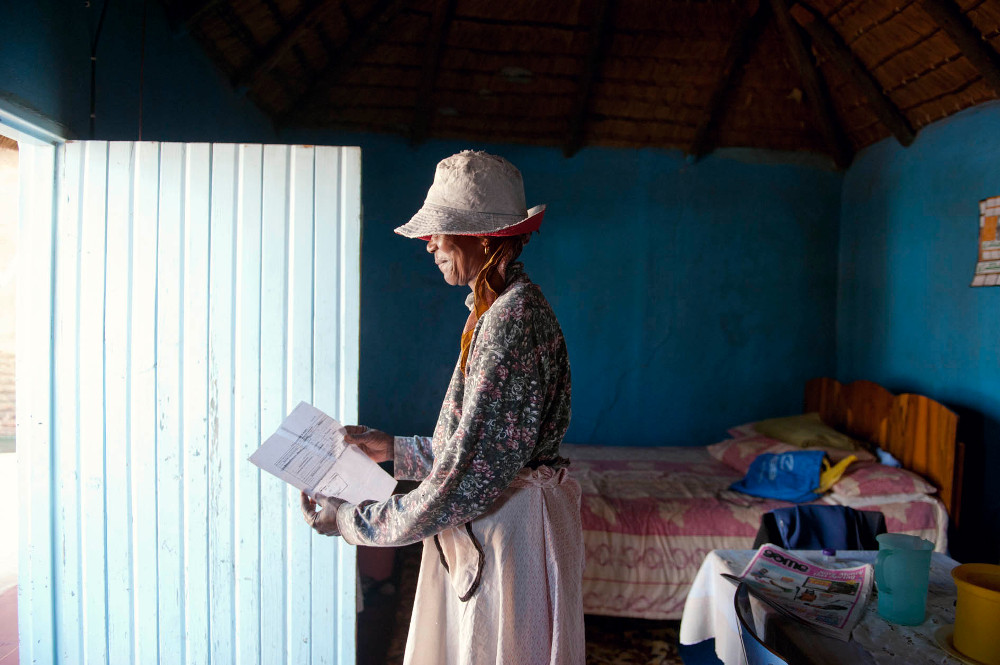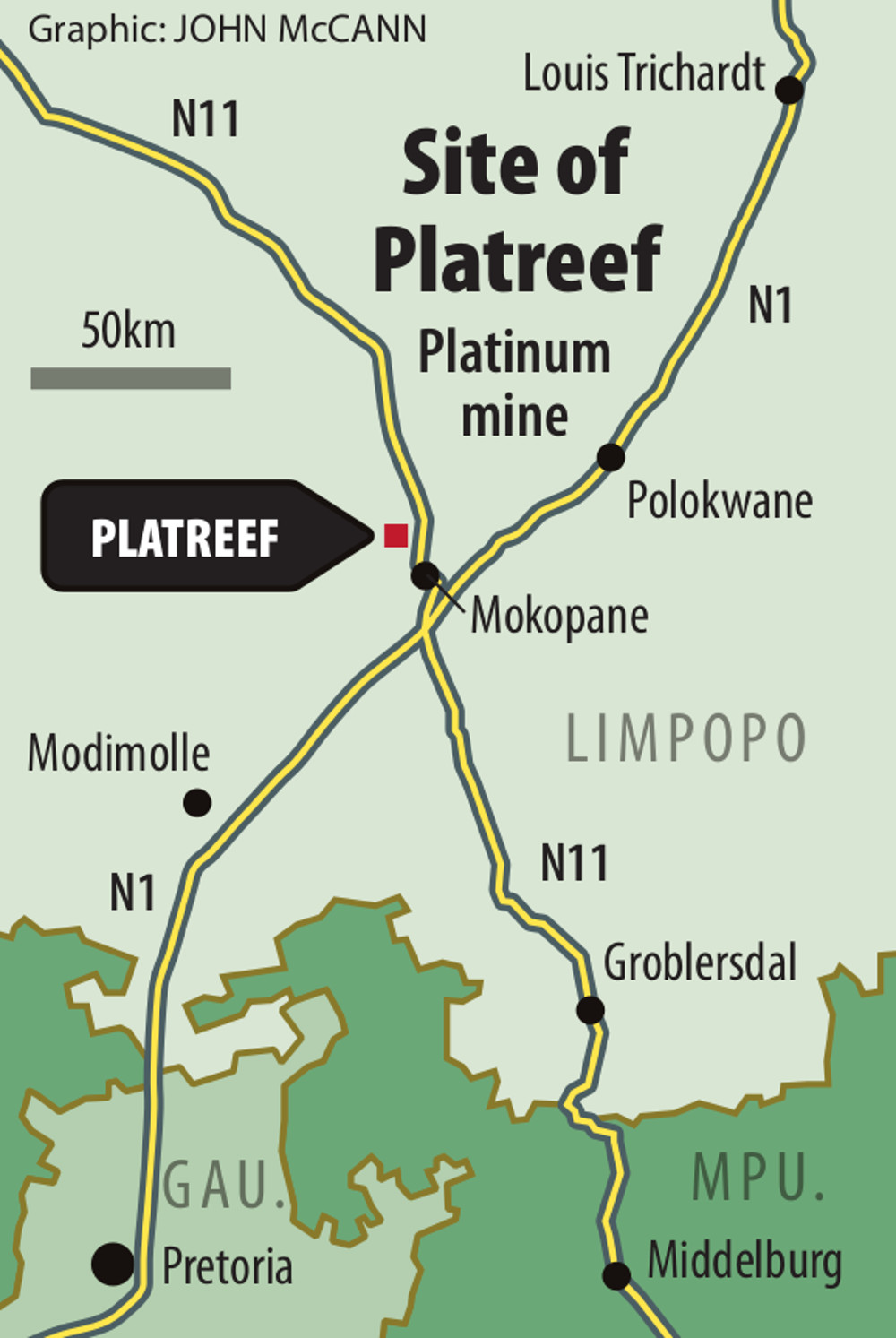The platinum mine will create 10 000 jobs in the area.
Margaret Makgabo feels the purple lump on her head caused by a rubber bullet. She says she has “become used to the pain”.
The 64-year-old pensioner from Mokopane in Limpopo was shot by police last month while protesting against a mining licence that was granted to Canadian mining company Ivanhoe.
The police say several hundred protesters threw rocks at them and they responded. The protesters claim this is part of a campaign to keep them quiet. As with most things relating to the mine, located north of Mokopane, the truth is opaque. Parts of the community and the mine are at loggerheads, with both insisting their truth is absolute.
The basic facts are straightforward. Ivanhoe – through its local subsidiary, Platreef – began prospecting in 1998. It found a rich concentration of platinum below the farming fields of five villages and applied for a mining right in July last year. This was signed by Ngoako Ramatlhodi, minister of mineral affairs, on November 5 this year.
The northern limb of the Bushveld Complex is already home to Anglo Platinum’s Mogalakwena mine. Its large grey dumps create an artificial wall on the northern horizon of the area under which Platreef is planning to mine.
Natural boundaries
Mountain ridges to the east and west hem the 150 000 people living in the area into a long valley. The agricultural town of Mokopane – previously known as Potgietersrus – sits to the south. A video of the Platreef website shows a sophisticated and highly mechanised mining operation driving what will be one of the world’s largest platinum mines.
But the facts depend on who is interpreting them. Everyone seems to have their own agenda. Makgabo was shot on November 26 after community members gathered in an attempt to stop the mining. She has been opposing the mining for several years and first spoke to the Mail & Guardian last year.
“They came and told us they were taking our land for the mine and it would be good for the community. But this land is our life and it is our home.”
She says she was told by a mining committee established by Platreef to sign over her fields in return for R5 250 a year in compensation. “When I said I did not want to sign, they said my grant would be taken from me,” she said last year.
Makgabo is part of the Mokopane Interested and Affected Communities Committee, one of the five community groups opposing the mining. It has splintered. They say the mine does not have their support to operate on their land and has not explained how communities will benefit.
Investment and job creation
Platreef says the underground platinum mine will bring $1.6-billion in investment and create 10 000 jobs. A broad-based black economic empowerment model will give a 20% shareholding to communities. But to own this, they need to buy the shares with their dividend payouts. Platreef says the shares will be administered by trusts, which will be used to invest in local development. Entrepreneurs and employees can own another 6%. Until these shares become profitable, it has promised to give R11-million a year to the community – or R6 a person every month.
Ivanhoe, which also has mines in the Democratic Republic of Congo, owns 64% of Platreef. A Japanese consortium owns the other 10%. Since 1998 the company has had several highly placed employees and directors.
Cyril Ramaphosa was a director until he resigned last year, with his office saying his share had been donated to the Shanduka Trust. A 2006 United States Securities and Exchange Commission notice lists Moses Mayekiso, now the head of the Workers and Socialist Party, as a director. He did not respond to questions about his time at Platreef.

Pensioner Margaret Makgabo was among the protesters shot with rubber bullets. She cites a lack of consultation on the project. (Madelene Cronjé, M&G)
The company spokesperson, Jeremy Michaels, told the M&G that Mayekiso has not been involved in Ivanhoe since 2007, but declined to say what his role used to be.
Platreef has consistently maintained that its mining application has the support of the community, through its traditional leader, Vaaltyn Kekana. At Kekana’s inauguration in 2001, after the death of the former chief, the head of Ivanhoe, Robert Friedland, presented him with a leopard skin. Kekana was paid R30 000 a month during the prospecting phase, which the company says is “reasonable remuneration for time spent on company activities”.
Chief dispute
But there is a dispute over who is the rightful chief in the area, following a split that resulted in two candidates with the same name and surname competing for the throne.
Thembisa Siyaya, a researcher at the University of the Witwatersrand who has looked into this dispute, says Kekana does not have the support of the whole community.
In her research paper on this, she notes: “The two chiefs take different views on the mining. Kekana supports the mining and has materially benefited from this position.”
The M&G has been unable to obtain comment from Kekana.
Kekana has facilitated Platreef’s consultation with the community. The mine says it paid him in part because of the logistical cost of his help. But representatives from two of the community groups opposing the current mining model say this situation prevents opposition.
“When you are meeting in the chief’s place, there is no chance of true democracy. He decides what is discussed and who attends,” says Derick Tsita of the Mokopane community committee.
Democratic model
They want a democratic model of representation that allows people to attend meetings in public spaces, he adds: “This thing of the mine saying the chief supports the mining and therefore we all support it cannot be right.”
But the groups opposing the mining are fragmented. The residents’ committee has split and there are at least five registered groups, each with its own mandate.
The representatives of each are eager to sit down with journalists and share their case in detail. Each account is slightly different, but dissatisfaction about the perceived undemocratic structure of the chief’s consultations and the share of the 20% community ownership dominate their narratives.
“A big problem is that we have no information. We still know nothing about the community share and what it means in real terms for local development,” says Aubrey Langa.
A member of the Kopano group, representing five of the 20 affected communities, he prefers to meet at a hotel on the outskirts of town. The community consultation so far has been about ticking boxes, “quantity instead of quality”, he says.
“The mine has a 30-year mining right, so what if we are still paying for our share when it closes and we do not have any development?”
‘More transparency’
He cites chapters of mining and environmental legislation to back up his argument. He wants “more transparency” so that the community can approach groups – such as the Industrial Development Corporation – and get loans to build local industry on the back of the mining.
Catalytic converter factories could be built instead of the raw platinum being dug up and exported without beneficiation, he says. In turn, Platreef has attacked Langa with statements questioning his veracity and claiming that he has a criminal record.
Platreef spokesperson Michaels says the mine is “committed to conducting its business in conformance with all applicable laws”.

It has consulted with the community over several years and the “vast majority” support the project, he said. Incidents of violence and intimidation have been due to “some detractors” who are trying to hold the project to “ransom”.
They are creating unrest and feeding the media misinformation, he says. “These individuals have no consideration for the common good of the broader community.”
Request for mediation
In May the Kopano grouping approached the regional mining development and environment committee, a provincial government body, and asked it to mediate between the community and the mine.
On May 30 the minerals department granted Platreef’s mining right, with certain environmental and social development conditions. The minister then had to sign this off, but there was a Cabinet reshuffle and it was held in abeyance.
Langa says the new minister, Ramatlhodi, is from the area and they met him at his house to share their problems. A formal meeting was then held on the periphery of the Mining Indaba in Johannesburg in October. “He appeared to listen to our concerns,” says Langa.
At the end of October the minerals department said the minister wanted an “urgent” meeting with Ivanhoe’s owner to discuss the community’s complaints. It said the department “cannot ignore complaints from the community and is duty-bound to listen to the communities and address their concerns”.
Several community members independently told the M&G that the department never came. At the same time, Platreef threatened to cut 325 jobs because it said it did not have a “definitive indication” that the right had been executed. On November 4 the mining right was notarised by Ramatlhodi. This is despite the fact that the Mokopane committee’s challenge to the provisional mining right, lodged in May, had not been dealt with.
Minister’s go-ahead
The minerals department did not respond to questions asking whether it had resolved the outstanding issues before granting the licence, despite having nearly three weeks to do so.
The minister’s signature meant the mine could start operations within 21 days of notifying the community – the day that community members were shot by police.
When the M&G visited the area last week, the fenced Platreef mining compounds inside the community were bustling with activity. Stacks of mining equipment were piling up. But with their options seemingly exhausted, residents sounded increasingly desperate.
Langa lets out a hollow laugh when asked about the future. “We will lie on the road and we will stop them. They have declared war on us and we will fight back. We will have another Marikana.”
The recent violence is just the start, he says. With national government seemingly failing to listen to the community and the mine pressing ahead with operations, it appears this is the only way people think they will be listened to.